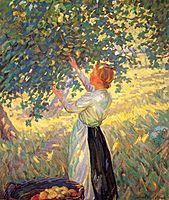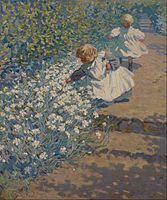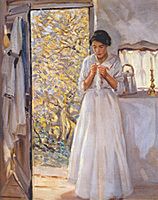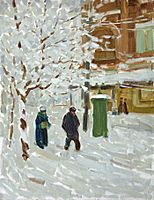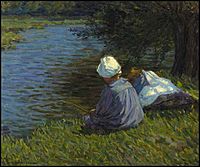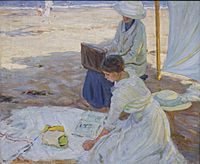Helen McNicoll facts for kids
Quick facts for kids
Helen Galloway McNicoll
|
|
|---|---|
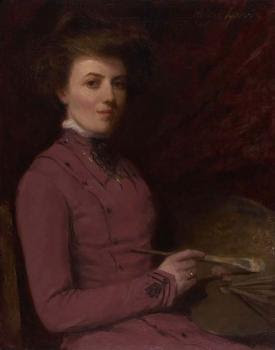
A portrait Helen McNicoll painted by Robert Harris, c 1910
|
|
| Born | December 14, 1879 Toronto, Canada
|
| Died | June 27, 1915 (aged 35) Swanage, United Kingdom
|
| Education | Art Association of Montreal, Slade School of Fine Art |
| Known for | Painter |
| Movement | Impressionism |
| Elected | Associate Royal Canadian Academy of Arts, Royal Society of British Artists |
Helen Galloway McNicoll (December 14, 1879 – June 27, 1915) was a talented Canadian Impressionist painter. She became one of Canada's most important women artists in the early 1900s. Helen had a successful career that lasted about ten years.
She helped make Impressionism popular in Canada. This art style was not well known there at the time. Helen's paintings showed bright country scenes, sweet pictures of children, and modern women. She was chosen to join the Royal Society of British Artists in 1913. In 1914, she became an Associate of the Royal Canadian Academy of Arts.
Contents
Biography
Early Life
Helen McNicoll was born in Toronto, Canada. Her family was well-off. Her parents, David McNicoll and Emily Pashley, had moved from Britain. Helen had six brothers and sisters. Letters and drawings show that her family was very close.
Her father worked in the railway business. This allowed Helen to meet important families. Her family's support meant she could paint freely. She did not have to worry about money. Helen likely first learned about art from her parents. Her father sketched during his travels. Her mother painted china and wrote poems.
When Helen was two years old, she became very hard of hearing. This was due to scarlet fever. She learned to read lips to talk with people. Her friends and family also helped her. In 1899, she took part in activities at a school for deaf students. However, she was not officially listed as deaf in the 1901 census. This was because people did not fully understand deaf culture back then.
Education and Career
From 1902 to 1904, Helen moved to London to study art. She went to the Slade School of Fine Art. There, she studied with Philip Wilson Steer. She might have met her good friend, Dorothea Sharp, at this school. Students at Slade were taught to paint in a natural way. They often painted en plein air, which means painting outdoors.
After Slade, Helen moved to St. Ives in England. In 1905, she studied at Julius Olsson's School. She learned landscape and marine painting there. She also studied with Algernon Talmage.
Helen later studied with William Brymner. He was one of the first Canadian artists to study in Paris. Brymner was a director at the Art Association of Montreal (AAM) school. He encouraged French art styles. These included plein air sketching and Impressionism. He also supported women artists in their careers.
Over time, Helen became very skilled in the Impressionist style. She was great at showing light in her paintings. Even shadows looked bright in her work. Her paintings had simple designs and beautiful subjects. She showed six paintings at the AAM's yearly exhibition. She also showed her art with the Royal Canadian Academy of Arts. This was from 1906 to 1914. Helen kept an art studio in London. She traveled around Europe from 1908 until she passed away.
World War I
Helen and Dorothea Sharp were working in France when World War I started. Helen wrote to her father saying they wanted to stay there. But because of her father's work with the Canadian Pacific Railway, she was sent back home.
Personal Life
Helen met British painter Dorothea Sharp while studying at the Slade School. They became very close friends. They even had nicknames for each other: "Nellie" and "Dolly." The two women traveled together. They shared art studios. They also posed for each other's paintings.
Having Dorothea as a friend was very helpful for Helen. This was especially true because of her hearing loss. Helen relied on Dorothea to help talk to models. This was important when they painted children. In Helen's painting The Chintz Sofa, Dorothea is shown in their shared London studio.
Death and Legacy
Helen McNicoll passed away in Swanage, Dorset, in 1915. She was only thirty-five years old. She died from problems related to diabetes. An article written after her death called her "one of the most original and skilled Canadian artists."
Helen had shown more than 70 paintings in Canada and Britain. Her art continued to be praised in the 1920s. The Art Association of Montreal held a special show of 150 of her paintings. This show celebrated her amazing career. It was called Memorial Exhibition of Paintings by the Late Helen G. McNicoll, RBA, ARCA.
The Art Gallery of Ontario also held an exhibition of her work in 1999. In 2021, they had a show called The Open Door: Mary Hiester Reid and Helen McNicoll. In 2023, her work was shown alongside Mary Cassatt in an exhibition. It was called Cassatt — McNicoll: Impressionists Between Worlds.
Style and Works
Helen McNicoll was known for how she painted light and air. She used bold colors. Her artworks were often described as "quiet." This might have been because of her hearing loss. Art critics often praised her paintings for their sunny feeling. She usually painted women, children, and country scenes.


